Browse Primary Sources
Locate primary sources, including images, objects, media, and texts. Annotations by scholars contextualize sources.
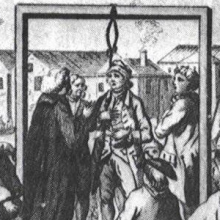
Execution of a Pirate in Wapping, London
This print by Robert Dobb depicts a pirate being hanged at Execution Dock in Wapping, London's largest seafaring neighborhood. Piracy was a capital offense in the 18th century and British authorities punished maritime criminals in Wapping in the hope that the gruesome spectacle would have a broad social effect and would discourage any would-be pirates.
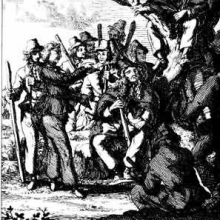
Anstis Crew Mock Trial
This is a print taken from Captain Charles Johnson's 1724 book, A General History of the Robberies and Murders Of the most notorious Pyrates, depicting a mock trial held by the pirate crew of Captain Thomas Anstis.
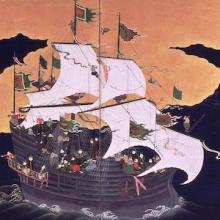
Japanese Nanbanjin Folding Screen
This byobu, or folding screen, was created by Kano Naizen ca. 1593-1603. Referred to as the Arrival of the Southern Barbarians (Nanbanjin) Screen, the byobu's two sides provide a unique visualization from the Japanese perspective of the relations between Japan and Portugal in the early modern period.
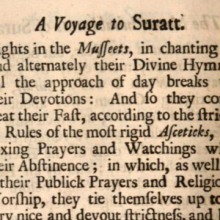
Excerpt from "A Voyage to Surat in the Year 1689"
Ovington’s travelogue “The City of Surat and Its Inhabitants,” an excerpt from John Ovington’s A Voyage to Surat in the Year 1689 provides students with a European trader’s point of view as he confronts the world of Islam during the Mughal rule of India. Its themes and habits of mind supplement the study of the years 1450-1750.
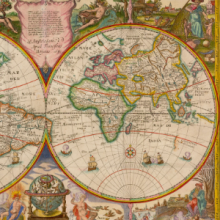
Nova Totius Terrarum Orbis Geographica Ac Hydrographica Tabula
First issued by Jodocus Hondius in about 1625, this rare map of the world is the first printed map that depicts the Australian continent. The map shows the rough outline of the western coast of Australia in the bottom righthand corner.
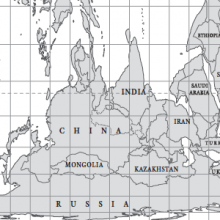
Hobo-Dyer Projection Worldmap
On a typical world map, such as the classic Mercator projection, Greenland appears misleadingly enormous – yet few observers pause to note the inaccuracies. Mapmakers rarely question other basic assumption, such as drawing north at the top. But if the Earth resembles ball spinning through space, are ‘up’ and ‘down’ so self-evident?
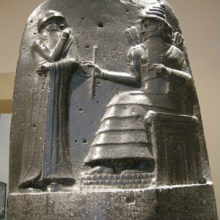
The Code of Hammurabi
This source is a part of the Hammurabi's Code teaching module.
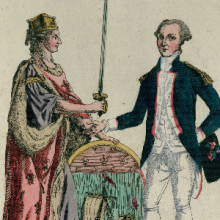
Mr. de Lafayette, Commander of the Paris National Guard, Receives the City’s 'Sword for the Defense of Liberty'
During the French Revolution the most visible connection between America and France was Lafayette, who had volunteered for service in the American Revolution and had been mentored by Washington and Jefferson. This special status vaulted him to prominence in 1789 as he became a delegate in the Estates–General, head of the National Guard, and a general in the military.
Rivonia Trial Speech
On April 20, 1964, Nelson Mandela gave what is now known as the Rivonia Trial Speech (also known as "I Am Prepared to Die") while on trial for crimes against the South African government. Mandela and several other leaders of the African National Congress (ANC) were arrested for their attempts to overthrow South African apartheid, a system of institutionalized racial segregation.
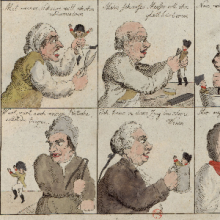
Six Part German Caricature: Napoleon Is Now Reduced to a Manageable Size!
Napoleon is mocked through this diminutive portrayal of the former conqueror.
Original Format
Engraving
Physical Dimensions
18.8 x 25 cm
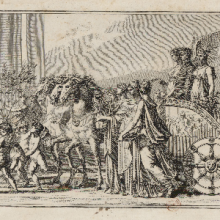
Triumph of Napoleon, First Consul
Napoleon encouraged comparisons between the post-revolution French republic and the Roman republic. The French adoption of the term "Consul" was a clear reference to the Roman Republic, for that was the name given the men chosen to direct the republican government in Roman times.
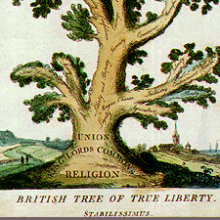
British Liberty Tree
These painted engravings ridicule the unrest wrought by French revolutionaries by contrasting French subversion with British stability. The "British Liberty Tree" in this image is assigned to the mock Latin genus of "Stabilissimus," while the more sickly looking "Foreign Tree" (depicted in the following image) is put in the genus "Subitarius."
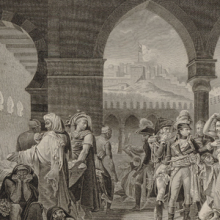
Bonaparte Visiting the Hospital in Jaffa
This undated post-French Revolutionary print shows Bonaparte visiting a hospital in Jaffa. Of classical proportions, this image is centered on Bonaparte, who appears to be bringing order to an otherwise disorderly and chaotic scene. However, Napoleon’s actual interest was limited, far less than this print would suggest.
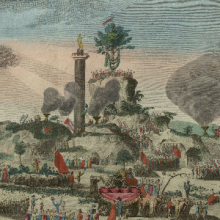
Festival of Supreme Being
These depictions show the Festival of the Supreme Being during the French Revolution, a massive pageant staged by Jacques–Louis David on 8 June 1794, in open air on the "Field of Reunion," formerly the royal army’s parade ground. At David’s orders, a huge mountain was erected on the field, as seen in this engraving.
Expulsion of the Girondins
Throughout the spring of 1793, radicals in the Convention, in the Paris Commune, and in the sections struggled for power against Brissot and his allies, known as the "Girondins." They differed over how the Revolution should be affected by popular pressure. In late May, Robespierre proposed a motion that accused the Girondins of being a threat to the Republic and ordered their arrest.

The Tragic End of Louis XVI
As 80,000 crowded into the square to watch the execution of Louis XVI, they cannot have been unaware that the guillotine sat where a statue of Louis XV had been. Here Sanson, the executioner, snatches the detached head of Louis XVI to show to the crowd. He leans forward with approving eagerness.
Robespierre’s Second Speech (28 December 1792)
As part of his defense, Louis’s lawyers had suggested the King should be judged not by the representatives of the people in the Convention but by the people themselves through a referendum. The Jacobins opposed this idea, fearing it would undermine the Convention’s position as embodying the will of the people.
The Petition of Right
In 1628, the position of Charles I of England had gone from bad to worse. Rash enterprises, lavish and illegal expenditure, and broken promises of better government had almost ruptured relations between the monarch and his subjects. The King offered to grant a "Confirmation of the Great Charter," such as had often been issued and then disregarded by former monarchs.

Liberty
Even before the French Revolution, the French had used a woman in a toga to symbolize liberty. By July 1789 this symbol had become quite common and would only grow more familiar over the revolutionary decade. Generally the female Liberty was a poised counterpart to the frantic actions of the Revolution. She represented calm like a saint.

Reason
To contemporaries who subscribed to the Enlightenment principles, preceding the French Revolution, the term "reason" was to be contrasted to superstition. Even though Christians, too, believed in reason, they also wanted to make room for the possibility of God’s intervention, particularly in miracles.